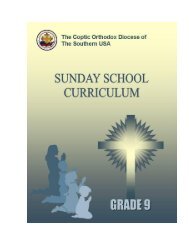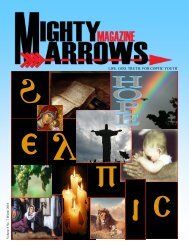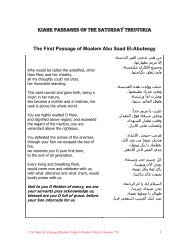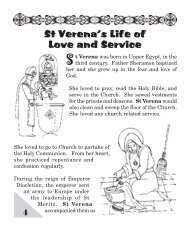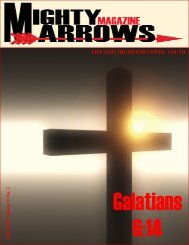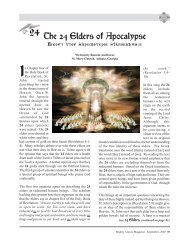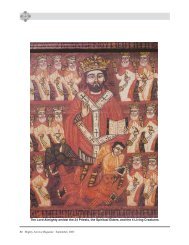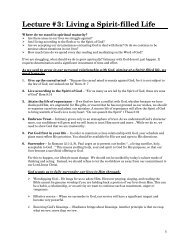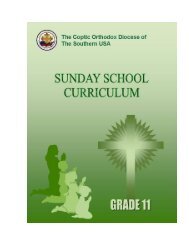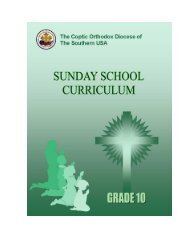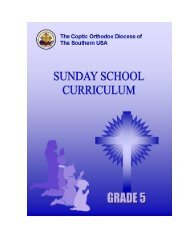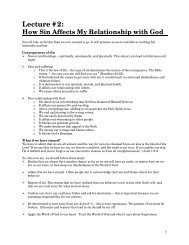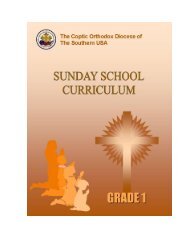Grade 12 - Coptic Orthodox Diocese of the Southern United States
Grade 12 - Coptic Orthodox Diocese of the Southern United States
Grade 12 - Coptic Orthodox Diocese of the Southern United States
Create successful ePaper yourself
Turn your PDF publications into a flip-book with our unique Google optimized e-Paper software.
Sunday School Curriculum <strong>Grade</strong> <strong>12</strong><br />
249 AD: The beginning <strong>of</strong> vicious persecution against <strong>the</strong> Christians at <strong>the</strong> time <strong>of</strong> Decius.<br />
Yet, by <strong>the</strong> end <strong>of</strong> <strong>the</strong> second century, Christianity has spread across much <strong>of</strong> <strong>the</strong> Roman<br />
Empire.<br />
300 AD: The great persecution during Diocletian and Galerius era. Several Christian<br />
communities and villages were wiped out in Africa, Egypt and Palestine.<br />
313 AD: Constantine <strong>the</strong> Great issued <strong>the</strong> ―Edict <strong>of</strong> Milan‖ granting freedom <strong>of</strong> worship to<br />
all religions and <strong>the</strong> first church was built.<br />
251-356 AD: St. Anthony started monasticism in Egypt, which subsequently spread, to <strong>the</strong><br />
whole world.<br />
590 AD: in <strong>the</strong> East, Muslims pushed westward, ending Christian dominance in North<br />
Africa and Palestine <strong>the</strong> birthplace <strong>of</strong> Christianity.<br />
1517AD: Martin Lu<strong>the</strong>r starting <strong>the</strong> Protestant reformation.<br />
II. The Council <strong>of</strong> Chalcedon 451 AD<br />
The Oriental <strong>Orthodox</strong> Churches including <strong>the</strong> <strong>Coptic</strong> Church recognize three ecumenical<br />
councils: Nicene I (325 AD), Constantinople I (381 AD), Ephesus (431 AD), while <strong>the</strong> Eastern<br />
<strong>Orthodox</strong> churches as well as <strong>the</strong> Roman Catholic Church recognize seven authoritative councils.<br />
These are Nicene I (325 AD), Constantinople I (381 AD), Ephesus (431 AD), Chalcedon (451 AD),<br />
Constantinople II (553 AD), Constantinople III (680 AD), and Nicene II (787 AD).‖ The council <strong>of</strong><br />
Chalcedon is an important council that divided <strong>the</strong> church to Chalcedonian and non-Chalcedonian<br />
churches. St. Dioscorus, <strong>the</strong> pope <strong>of</strong> Alexandria at that time defended <strong>the</strong> belief <strong>of</strong> our church about<br />
<strong>the</strong> one incarnate nature <strong>of</strong> <strong>the</strong> Word <strong>of</strong> God (Miaphysis). The meaning <strong>of</strong> mia- is one, but not single<br />
one or simple one but ―unity one‖ out <strong>of</strong> <strong>the</strong> Divine and <strong>the</strong> human natures <strong>of</strong> our Lord Jesus Christ<br />
without absorption or confusion <strong>of</strong> any <strong>of</strong> <strong>the</strong> natures. Our church is considered a non-Chalcedonian<br />
because we refused <strong>the</strong> <strong>the</strong>ology accepted at this council that considered <strong>the</strong> one nature <strong>of</strong> Christ as<br />
one <strong>of</strong> two that were absorbed toge<strong>the</strong>r<br />
III. Egypt and Its Unique Church<br />
If we look to <strong>the</strong> circumstances <strong>of</strong> <strong>the</strong> Church <strong>of</strong> Alexandria (Egypt), Mrs. Butcher says that if<br />
<strong>the</strong>re are seven wonders in <strong>the</strong> world, <strong>the</strong> existence <strong>of</strong> <strong>the</strong> Church in Egypt is one <strong>of</strong> <strong>the</strong> wonders in<br />
this world! The secret <strong>of</strong> all this, is <strong>the</strong> divine promise “Blessed My people Egypt” (Isaiah 19:25),<br />
and <strong>the</strong> coming <strong>of</strong> <strong>the</strong> Lord Jesus Christ to it.<br />
To Egypt and not a single nation, Joseph came to build warehouses and fulfill <strong>the</strong> needs <strong>of</strong> <strong>the</strong><br />
Egyptians and o<strong>the</strong>rs during <strong>the</strong> famine. And only to it, <strong>the</strong> Lord Jesus Christ escaped to build with<br />
His presence a holy altar and make from it a unique church which Isaiah <strong>the</strong> prophet has prophesied<br />
about (Isaiah 19).<br />
IV. What Was The Church In Egypt Known For?<br />
1. A refuge to <strong>the</strong> Lord Jesus Christ: The Baby Jesus has escaped to it, with His mo<strong>the</strong>r and St.<br />
Joseph, riding on a light fast cloud (Isaiah 19:1), destroying its idols, and made <strong>of</strong> it a blessed<br />
people. It is <strong>the</strong> only one, which had this divine promise. “Blessed My people Egypt” (Isaiah<br />
19:25). The Church <strong>of</strong> Alexandria is still proud <strong>of</strong> her Christ, hiding inside her, and she hides in<br />
Him.<br />
NOVEMBER 71



